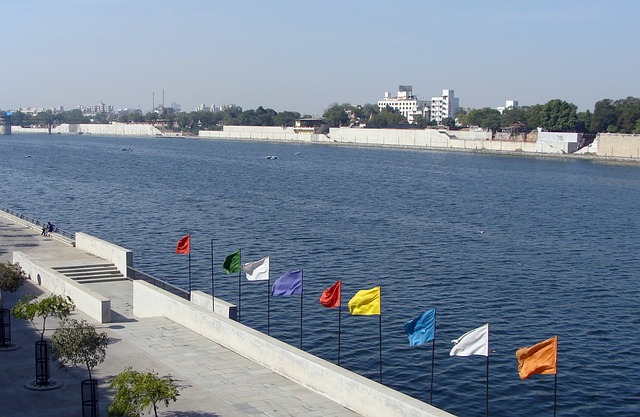The Sabarmati Riverfront Project: A Transformation of Urban Landscape

The Sabarmati Riverfront Project is an ambitious urban development initiative undertaken in the city of Ahmedabad, Gujarat, India. This project, designed to revitalize the Sabarmati River and its surroundings, represents a significant milestone in urban planning and environmental management. It seeks to address multiple urban issues while enhancing the quality of life for residents and promoting sustainable development.
Historical Background of Sabarmati River
Ahmedabad, located on the banks of the Sabarmati River, has a rich historical and cultural heritage. The city has been an important center of commerce, culture, and politics for centuries. However, over the years, the river had suffered from neglect, pollution, and encroachment, leading to severe environmental degradation. The idea of redeveloping the riverfront was first conceived in the 1960s, but it wasn’t until the early 2000s that the project gained momentum under the leadership of the Ahmedabad Municipal Corporation (AMC) and the Gujarat Urban Development Company Ltd (GUDCL).
Project Vision and Objectives of Sabarmati Riverfront
The primary vision of the Sabarmati Riverfront Project is to transform the neglected river into a vibrant public space that serves as a catalyst for urban renewal. The objectives of the project include:
- Environmental Restoration: Cleaning and rejuvenating the river to improve water quality and restore its ecological balance.
- Flood Control: Implementing flood management measures to protect the city from seasonal flooding.
- Public Access: Creating accessible public spaces along the riverfront for recreation, cultural activities, and social gatherings.
- Urban Connectivity: Enhancing connectivity between different parts of the city and reducing traffic congestion.
- Economic Development: Stimulating economic activities through commercial development and tourism.
- Social Equity: Ensuring that the benefits of the project are accessible to all sections of society, including marginalized communities.
Phases of Development
The project is being implemented in multiple phases, each focusing on specific aspects of development.
- Phase 1: The initial phase involved the construction of retaining walls along the riverbanks to prevent erosion and encroachment. This phase also included the development of basic infrastructure, such as roads, promenades, and parks. A total of 11 km of the riverfront was developed in this phase.
- Phase 2: This phase focused on extending the riverfront by an additional 5.5 km between Subhash Bridge and Indira Bridge. Key developments included the creation of parks, gardens, and recreational facilities. Special attention was given to landscaping and beautification to enhance the aesthetic appeal of the area.
- Phase 3 to 7: The subsequent phases aim to extend the riverfront further, reaching up to the Pethapur thermal power plant in Gandhinagar. These phases, currently in various stages of planning and execution, will collectively add 22 km to the riverfront, making the total length 38.5 km, the longest riverfront in the world. These phases will also involve integrating advanced flood management systems and creating more public spaces.
Key Features and Achievements
- Public Spaces: One of the most notable achievements of the project is the creation of extensive public spaces. The riverfront now boasts beautifully landscaped gardens, parks, and promenades that provide citizens with areas for leisure and recreation. Iconic spots like the Atal Pedestrian Bridge and the Flower Park have become popular destinations for both residents and tourists.
- Environmental Benefits: The project has significantly improved the water quality of the Sabarmati River. Efforts to clean the river and prevent industrial effluents from entering it have helped restore its ecological balance. Additionally, the project has increased the green cover along the river, contributing to a reduction in urban heat island effects and enhancing biodiversity.
- Flood Management: The construction of retaining walls and other flood control measures has effectively mitigated the risk of flooding. This has not only protected the city from potential flood damage but also provided a sense of security to the residents.
- Economic Impact: The redevelopment of the riverfront has spurred economic growth in the region. The area has witnessed a rise in commercial activities, with new businesses, cafes, restaurants, and shops opening up along the riverfront. This has created job opportunities and boosted the local economy. The riverfront has also become a significant tourist attraction, drawing visitors from across the country and beyond.
- Social Impact: The project has promoted social inclusivity by providing accessible public spaces that cater to people from all walks of life. Events such as cultural festivals, concerts, and exhibitions are regularly held on the riverfront, fostering a sense of community and cultural exchange.
Challenges and Criticisms
Despite its numerous achievements, the Sabarmati Riverfront Project has faced several challenges and criticisms.
- Displacement and Resettlement: One of the major criticisms of the project is the displacement of slum dwellers and informal settlements along the riverbanks. While efforts were made to resettle the affected families, there have been concerns about the adequacy and quality of the resettlement process.
- Environmental Concerns: Some environmentalists have raised concerns about the long-term ecological impact of the project. The construction activities and modifications to the river’s natural flow have been points of contention.
- Maintenance and Sustainability: Ensuring the long-term maintenance and sustainability of the riverfront is a significant challenge. Continuous efforts are needed to manage waste, prevent pollution, and maintain the infrastructure.
Future Prospects of Sabarmati Riverfront Project
The future prospects of the Sabarmati Riverfront Project are promising. As the subsequent phases of the project progress, the riverfront is expected to become even more integral to the city’s urban fabric. The extension up to the Pethapur thermal power plant will enhance connectivity between Ahmedabad and Gandhinagar, fostering regional integration and development.
Moreover, the project can serve as a model for other cities facing similar challenges. The holistic approach to urban renewal, which balances environmental, social, and economic objectives, can provide valuable lessons for urban planners and policymakers worldwide.
Come, Visit Sabarmati Riverfront
The Sabarmati Riverfront Project is a transformative urban initiative that has redefined the relationship between Ahmedabad and its river. By addressing environmental degradation, enhancing public spaces, and promoting economic growth, the project has significantly improved the quality of life for the city’s residents. While challenges remain, the project’s successes offer a compelling vision of how urban spaces can be revitalized in a sustainable and inclusive manner. As the project continues to evolve, it holds the potential to set new benchmarks in urban development and inspire similar efforts globally.


